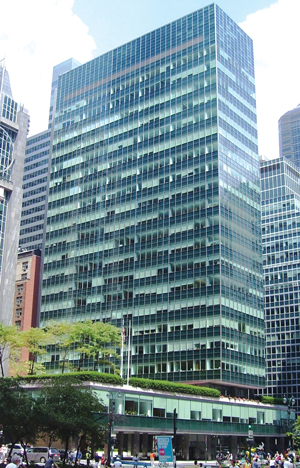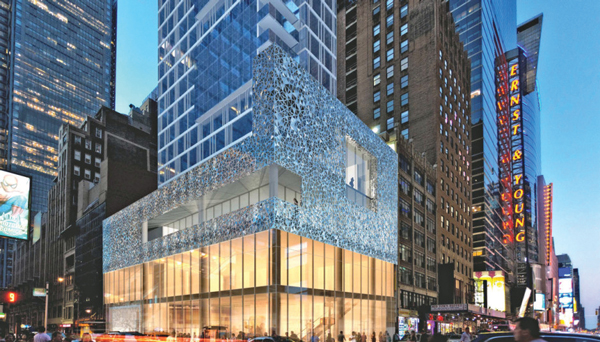Trending
Is New York real estate showing symptoms of distress?
As new signs of trouble pop up, TRD zooms in on property types across the city to see where there are cracks in the veneer

For Hans Futterman, it was a dream defaulted.
The developer assembled a vacant plot of land — formerly a Shell gas station and a parking lot — at Frederick Douglass Boulevard and West 122nd Street in Harlem over roughly four years, from 2011 to 2015. He then secured approvals to construct a 12-story, 127-unit residential building on the site, which offers 205,000 buildable square feet.
But in June of last year, Futterman, who declined to comment for this story, defaulted on a $36 million loan from RWN Real Estate Partners, and five months later his development firm filed for Chapter 11 bankruptcy protection. The bankruptcy auction is now set for June 21, and sources said the site could sell for as much as $70 million — about $44 million more than Futterman paid for the stretch of land over the years.
A source said Futterman pumped “his life savings” into the project — and that he is still holding out hope to develop it himself.
“This is the reality of the market today,” said Cushman & Wakefield’s Bob Knakal, who is handling the bankruptcy auction with colleague Adam Spies. “Transactions are not going the way owners want.”
Indeed, the first signs of distress have emerged in several pockets of New York City’s commercial real estate market in recent months. Retail vacancies, declining hotel revenues and foreclosures on Park Avenue are among a flurry of indications that the market is inching closer to the brink of financial trouble.
“There’s a lot more stress in the system than most people probably realize,” said Iron Hound Management’s Robert Verrone, who added that his mortgage brokerage is handling more workouts nationally than ever before.
The influx of troubled loans is a product of the 2007 lending boom, and $90 billion in commercial mortgage backed-securities backed by properties across the country are set to mature this year. Sean Barrie of Trepp, which tracks CMBS, noted that the massive batch of loans was “underwritten pretty liberally,” and now, many of those sponsors may face difficulty refinancing their over-leveraged assets.
 Attorney Ray Hannigan, of Herrick Feinstein, who specializes in foreclosures and workouts, said the tri-state area is already seeing a substantial influx of those maturity defaults.
Attorney Ray Hannigan, of Herrick Feinstein, who specializes in foreclosures and workouts, said the tri-state area is already seeing a substantial influx of those maturity defaults.
“It’s a long time coming,” he said. “The market needs to work through this latest cycle and weed out the good and the bad.”
The bad can be found across the five boroughs. In Brooklyn and Staten Island, scheduled foreclosure auctions are making a comeback. There were 90 foreclosure auctions in Brooklyn in March, a 125 percent year-over-year increase. Staten Island — where the real estate market has been less active — had 32 in the same month, a 10 percent increase from the previous year, according to data provided to The Real Deal from California-based research firm ATTOM Data Solutions.
ATTOM data also showed that there was a 327 percent increase in New York City multifamily and retail sales to third-party investors in foreclosure auctions in 2017’s first quarter, year-over year. Similarly, the number of bank-owned commercial properties rose 8 percent year-over-year.
No one is suggesting that distress is widespread — yet. More than 25 lawyers, economists, lenders and brokers who spoke to TRD for this story were confident that although a decline is around the corner, it won’t be as severe as it was 2007 or 2008 — when, as attorney Wallace Schwartz of the national law firm Kasowitz put it, “everything fell off the table.”
“Distress is a very macro word,” said Ayush Kapahi of capital advisory firm HKS Capital Partners. “There’s something churning. I don’t know if the word ‘distress’ will apply, or if it will just be a market reset.… There are so many variables that go into a storm.”
To get a better idea of the extent of the trouble in the market, TRD took a temperature check of all the commercial real estate asset classes across the city.
Retail anxieties
When real estate developer Billy Macklowe proclaimed, “I think retail is fucked, plain and simple,” in late April, he was echoing a sentiment widely shared among industry insiders: Of all commercial real estate asset classes, retail is showing the clearest signs of distress.
“Retail is a disaster in New York City,” one source said on the condition of anonymity. While part of that situation is due to the continual rise of online retailers, “another part of it is people are too greedy,” the source added in reference to landlords seeking steep rents.

Lever House
Indeed, brick-and-mortar stores across the country are collapsing due to high overhead, weak sales and mounting debt, and major U.S. retailers including American Apparel and Aeropostale, among many others, have filed for bankruptcy.
Some retailers are making real estate moves to stay afloat amid falling sales. Department store Lord & Taylor is considering adding a residential tower on top of its flagship at 424 Fifth Avenue and Neiman Marcus recently met with Related Companies about a potential merger — a deal that Related chair Stephen Ross later said would not happen.
No major retail landlords in the city have defaulted on their loans because of the waning market, but many are seeing increased vacancies. Last year, availability rates on Fifth Avenue between 42nd and 49th streets hit a high of 31 percent, Cushman data show. All in all, eight of Manhattan’s 11 major retail neighborhoods saw availability rates grow between 0.6 and 8.2 percent, according to the commercial brokerage.
“Look anywhere in the city and you see unusually high vacancy,” said real estate attorney Joshua Stein. To be sure, there is more leasing activity taking place on less-glamorous stretches like Ninth Avenue (see related story).
Most recently, Ralph Lauren announced it would be closing its 39,000 square-foot flagship store at the Coca-Cola
Company’s 711 Fifth Avenue. The retailer will continue to pay a whopping $70,000 per day in rent as part of the lease, which expires in 2029, if it can’t get out of the arrangement.
And as leasing volume slows, landlords are wooing new tenants by offering concessions, including cheaper rents, build-outs and more flexible deal terms.
If any major retail landlord is approaching trouble, it could be Thor Equities’ [TRDataCustom] Joseph Sitt (see related story), whose portfolio has retail vacancies, including nearly 27,000 square feet of vacancies at 530 Fifth, which the firm co-owns with General Growth Properties.
And Sitt certainly isn’t alone.
Jack Terzi’s JTRE Holdings, for example, has reportedly been in contract for nearly a year to pay about $140 million for a vacant six-story retail building at 23 Wall Street. Sources said that over that time, Terzi has had difficulty locking in financing and securing a flagship tenant, though Uniqlo is among the prospective retailers that have negotiated for space there.
Of the $7.53 billion in 200 CMBS notes backed by retail properties in New York City, five, totaling $77 million, are with a special servicer, according to Trepp.
“Retail dynamics and challenges are certainly not unique to New York,” said Sam Chandan, an economist and associate dean at New York University’s Schack Institute of Real Estate. “New York has a very unique retail footprint by virtue of it being a dense tourist market and one where most retail is ground floor or street-facing. There will be some difficult adjustments.”
Hotel oversupply
The hotel industry is also facing an uphill battle to absorb oversupply in the city and combat online home-sharing marketplace Airbnb.
“The industry’s struggle is really playing out in the room rates, which have declined and are expected to continue to do so,” said Peter Muoio, chief economist and head of research at online real estate marketplace Ten-X.

Aby Rosen
Revenue per available room fell to $163 during the first three months of this year — its lowest level of the current cycle and a 2.3 percent drop year-over-year, according to a recent report from hotel-and-data analytics firm STR.
Transactions are also down, as New York City saw $2 billion in hotel deals in 2016, a sizable drop from $4.8 billion the prior year, according to STR. The 2015 figure, it should be noted, included the blockbuster $1.95 billion sale of the Waldorf Astoria to Anbang Insurance Group. Many of the 2016 deals were for “upper midscale” or “upscale” properties, unlike 2015 when most hotels that sold were “luxury” or “upper upscale,” according to the data firm’s report.
Sources said that so far, hotel owners have been able to largely escape trouble with a “big paydown” through a recapitalization or a sale, but the few hotels that were sold in the last two years have done so at a loss. Thor has been in contract since the fall to purchase PGIM Real Estate’s five-star James New York hotel in Soho for $70 million — a $13 million drop from the property’s previous sale price of $83.4 million in 2013.
While some hotels are simply depreciating in value, at least one is facing foreclosure. The four-star, boutique Mansfield Hotel at 12 West 44th Street in Midtown has been hemorrhaging cash for more than a year as the owner, Ark Partners, has struggled to sell for $65 million.
Court records show Wells Fargo, the trustee on the hotel’s $20 million loan, is working through foreclosure proceedings with the developers.
A wide range of Manhattan hotels are on the market, though very few have been able to find a buyer quickly. The properties on the hunt include the Park Lane Hotel, the Quin, the Standard High Line and Hotel Wales.
Hotels have had a better shot at selling when marketed as a development or conversion opportunity, sources say. The LeFrak Organization is planning a rental conversion of the 37-story Affinia-branded Dumont NYC hotel in Kips Bay. Both the Dumont and the nearby Morgans Hotel, which is in contract to be sold to an unidentified developer, are set to close this summer.
“The New York City hotel market has been hammered for so long,” said JLL’s Jeffrey Davis, who is brokering the Morgans Hotel deal. “Nationally, it’s been one of the spots of concern for the past few years. But I’m betting on New York to emerge out of that as other markets are going in.”
Nonetheless, there are 13,604 rooms and 79 hotels coming online in New York City through the end of 2018, according to STR. That could further drive down demand.
“The bottom line is hotels are no longer the highest and best use,” said one prominent hotel-mortgage broker on the condition of anonymity.
Office woes
In the last several months, two of the city’s most iconic office towers — the Brill Building at 1619 Broadway and Lever House at 390 Park Avenue — fell into foreclosure.
At Brill, Brookfield Property Partners, the building’s lender and also a major owner and developer, took full control of the landmarked 175,000-square-foot building in March after the majority owners — unable to cover their investment through retail and office leasing — failed to pay $5.6 million in mezzanine debt.
Last year, Aby Rosen’s RFR Holding defaulted on a $98 million CMBS mortgage backed by the leasehold on the 21-story Lever House. Rosen was unable to refinance the note because of an “escalation clause” in the ground lease that will reset the terms of the ground rent significantly starting in six years. And in November, Wells Fargo filed a foreclosure proceeding on the property. A special servicer indicated that the resolution is slated for this December, according to Trepp data.
The Lever House foreclosure “highlights the perils of ground leases,” said Stein, who is not involved in the case. “Sometimes, when there’s a rent reset in a frothy market, tenants just can’t pay those stupendous numbers.”
Industry sources consider these examples to be isolated cases and not representative of larger distress.
“We’re seeing foreclosures of New York City office buildings in special situations — quirky ground leases or a big revaluation on a ground lease,” said Iron Hound’s Verrone. “I haven’t seen a traditional office building default yet.”
On the whole, office leasing across the boroughs has been healthy. More than 9 million square feet in deals were signed in the first quarter, according to Colliers International. The vacancy rate and absorption in Manhattan are relatively stable — at 10.2 percent and negative 127,000 square feet, respectively, a first-quarter Colliers report shows.
However, much of the leasing activity has been driven by concessions: Manhattan’s office landlords offered incentives valued at an average of $173 per square foot in the first quarter, about 2.5 times greater than they were just a decade ago, Savills Studley data showed. They also gave 12 to 15 months of free rent on average.
Absorption is especially low in Brooklyn, where about 7 million square feet of office space is in the pipeline despite very little interest from big-name Manhattan tenants. Amid the growing oversupply, the vacancy rate in Brooklyn reached 7.1 percent in the first quarter, up from 5.7 percent in late 2015, according to CoStar Group data.

Sharif El-Gamal
“Office is holding its own, but is under tremendous stress,” said lawyer Eugene Pinover of DLA Piper. “Everyone renewing office leases used to tack on an additional 20 percent of square footage. Now, those companies are taking 20 percent less.”
Multifamily glut
While the city’s multifamily market continues to serve as a safe haven for investors, the vibe is definitely not as positive as it was just two years ago. Fewer deals are getting done in several key multifamily markets such as Northern Manhattan and Brooklyn.
Multifamily is the one sector where deal volume is falling the most, said Real Capital Analytics’ Jim Costello. Dollar volume in the sector was down 60 percent year-over-year, to $1.6 billion, in the first quarter, an Ariel Property Advisors report shows.
The roughly 15-month absence of a 421a tax abatement — which was revived in April under the moniker Affordable New York — was responsible for the dearth of new-construction multifamily projects in the past year.
Perhaps the most blatant recent example of an implosion in multifamily is the saga involving controversial 27-year-old landlord Raphael Toledano, his lender Madison Realty Capital and 15 troubled East Village walk-ups. Toledano secured a hefty $124 million loan for the $97 million acquisition and renovations of the buildings in 2015.
Fast-forward a year and a half: Madison filed to foreclose on the portfolio; an affiliate of Toledano’s firm, Brookhill Properties, filed for Chapter 11; and a court approved Madison as the new property manager. Madison, which has been accused of loan-to-own practices in the past, is in the process of acquiring the deeds from Toledano, who has very few remaining buildings in his possession.
But some industry players say that scenario has more to do with predatory lending than distress in the New York multifamily market. In fact, the Rent Guidelines Board released data in April that showed the number of “distressed” properties with stabilized units reached its lowest point — 5.4 percent — since 1990.
Still, multifamily properties are often the last to take a financial hit due to stable rent prices and the necessity of housing, sources say. And high-end rental buildings are usually the hardest hit when the economy weakens. Several prominent landlords, including the Moinian Group and the Durst Organization, have recently started to cut their rents and even offer concessions to tenants to avoid vacancies, as TRD reported last month.
As of May 12, there were 2,300 active rental listings in Manhattan and 600 in Brooklyn and Queens offering free rent or brokerage fees paid by the landlord, according to a monthly report by Town Residential. Respectively, 62 percent and 65 percent of those incentives were on units priced between $2,500 and $5,000 a month.
“There has been relatively slight downward pressure on rents,” said Stein. “But the fact that there would be any downward pressure at all is remarkable.”
There are more telling signs of distress in multifamily than landlords caving to concessions to fight vacancies. In the CMBS space, industry players are seeing loan defaults on multifamily properties, according to Herrick Feinstein’s Hannigan.
“You’ll see a lot of special servicers pursuing foreclosure and workouts of apartment complexes, and other types of properties, across the board,” he said.
Land sales slump
In May, lender Colony Capital sold $63 million in distressed debt on the development site at 560 Seventh Avenue in Chelsea, owned by Soho Properties’ Sharif El-Gamal and MHP Real Estate Services to an unidentified firm, sources told TRD. In court documents, the lender claimed El-Gamal and partners had defaulted on the debt. Sources with knowledge of the deal said that the trouble unfolded because El-Gamal had trouble securing construction financing for the 29-story Dream Hotel he was planning at the site. A representative for El-Gamal denied that his firm had difficulty securing financing.
The NoMad-based developer is not alone. Lenders held back on financing many land acquisition and construction deals — not only for luxury condominium projects but for commercial developments across the board.

A rendering of the Dream Hotel at 560 Seventh Avenue
As a result, land sales had a pretty damaging 2016, and the number of deals crossing the goal line was significantly diminished. Dollar volume plummeted 74 percent year-over-year to less than $3 billion, according to data from Cushman.
Kasowitz’s Schwartz said distress is occurring more so “on the front end.”
“We’re seeing a dislocation between buyers and sellers with respect to pricing on ground-up multifamily and land sales,” he said. “This is causing buyers and sellers to seek alternate structures in the form of land contribution joint ventures and ground leases so that the sellers can retain some upside in the project and bridge the price dislocation.”
But bringing in an equity partner isn’t always an easy solution.
“Construction lenders are asking a lot of questions and don’t want untested developers,” Hannigan said, adding that he is seeing “a lot of stress in joint ventures,” which has been playing out in litigation.
In one example, Richard Ohebshalom sued his father, Fred, in March for allegedly trying to push through the $148 million sale of a large Financial District development site at 111 Washington Street for less than he thought it was worth.
And deals from the past — particularly cases where a developer bought land at high prices in 2014 and 2015 — are coming back to haunt both owners and lenders who just can’t make the numbers work in today’s market.
The Durst Organization, one of the city’s biggest developers, is seeing those distressed development sites as a source of opportunity. Last December, the firm bought a Long Island City development site from Property Markets Group and the Hakim Organization for $173.4 million. The partners had spent almost three years assembling several lots in a total of four purchases to make way for a $750 million, 914-foot-tall rental and condo tower. But when the developers’ $140 million acquisition and pre-development loans from Acres Capital were coming due, the duo realized they couldn’t line up a new lender without sinking more equity into the deal. To dodge foreclosure, they sold the parcels.
Durst Organization CEO Douglas Durst explained its strategy to TRD earlier this year, saying, “We cannot compete with condo builders on cost when acquiring land conventionally. Acquiring distressed sites allows us to build rental and make the kinds of long-term investments that have served us well for more than 100 years.”
And it seems as though the opportunities will be in greater supply. There was a 9 percent year-over-year increase in scheduled foreclosure auctions on vacant land in the first quarter, driven by a 114 percent jump in Brooklyn, ATTOM data showed. Scheduled foreclosure auctions were also up year-over-year in Queens and on Staten Island, and bank repossessions were up in Brooklyn, Manhattan and the Bronx, the data showed.
Ackman-Ziff Real Estate’s Russell Schildkraut said a “most suspect” corner of the market is in land sites that were bought by second-tier sponsors that are not adequately capitalized or overleveraged.
“They’re stuck without a way to get projects done,” Schildkraut said.
Correction: A previous version of this story incorrectly identified the amount of vacant space at 530 Fifth Avenue. It is nearly 27,000 square feet.
(To view transactions completed at the peak of the market, between January 1st 2014 and December 31st 2015, click here to see commercial sales and click here to see retail leasing)




